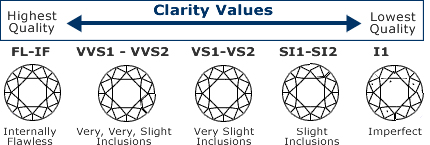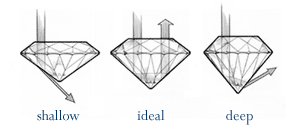 |
Inquire Online or Call
800-411-0951 |
 |
|
|
|
|
|
|
|
|
|
|
Diamond Buyer's Guide
|
|
| Anatomy of a Diamond |
|
Diameter: The width of the diamond as measured through the girdle.
Table: The large, flat top facet of a diamond; a key factor in ideal cut diamonds.
Crown: The upper portion of a cut gemstone, above the girdle.
Girdle: The narrow rim of a diamond that separates the crown from the pavilion. It is the largest diameter to any part of the stone.
Pavilion: The lower portion of the diamond, below the girdle. It is sometimes referred to as the base.
Culet: The tiny facet on the pointed bottom of the pavilion, which is the portion of a cut gem below the girdle.
Depth: The depth of a stone measured from the table to the culet; a key factor in determining "fine cut" diamonds.
Facet: A plane, polished surface on a diamond or other gemstone.
|
| The 4 C's of Diamonds |
|
| 1) Color |
Grades in the color of diamonds range from D-Z, D being truly colorless and of the highest quality. E and F are also graded as colorless while G, H, I and J are near colorless. Stones grades K, L, and M will have obvious hints of color and as the scale approaches P you may find subtle changes in hue and tone.
The exceptions to the rule are "Fancy Color" diamonds, which are particularly rare and highly treasured. Natural colored diamonds are formed in the same way as colorless white diamonds with the only difference being the color of the crystal. Natural colored diamonds come in all shades, hues and colors of the rainbow, with some of the most popular colors being shades and combinations of pink, blue, brown, yellow, orange, green and red. Yellow is the most commonly-occurring fancy color, while red and green diamonds are extremely rare.
The price of fancy colored diamonds is dependent on several factors: the particular hue of the diamond (the rarer the color, the greater the cost); the richness or saturation of the color (ranging from very light to light to intense to vivid); the purity of the color (i.e. whether the color is bright and clear, or clouded); and market availability.
|
|
 |
|
| 2) Clarity |
|
Clarity describes the clearness or purity of a diamond. This is determined by the number, size, nature, and location of the internal (inclusions) and external (blemishes) imperfections. The clarity scale is broken down into the following grades:
|
|
 |
|
| Symbol |
Meaning |
Definition |
| F |
Flawless |
Free from all
inclusions or blemishes. |
| IF |
Internally Flawless |
No inclusions
visible at 10x magnification. |
| VVS1 |
Very Very Slightly
Included #1 |
Inclusions that are
extremely difficult to locate at 10x. |
| VVS2 |
Very Very Slightly
Included #2 |
Inclusions that are
very difficult to locate at 10x. |
| VS1 |
Very Slightly
Included #1 |
Minor inclusions
that are difficult to locate at 10x. |
| VS2 |
Very Slightly
Included #2 |
Minor inclusions
that are somewhat difficult to locate at 10x. |
| SI1 |
Slightly Included
#1 |
Noticeable
inclusions that are easy to locate at 10x. |
| Sl2 |
Slightly Included
#2 |
Noticeable
inclusion that are very easy to locate at 10x. |
| I1 |
Included #1 |
Obvious inclusions.
Somewhat easy to locate with the unaided eye. |
| I2 |
Included #2 |
Obvious inclusions.
Easy to locate with the unaided eye. |
| I3 |
Included #3 |
Obvious inclusions.
Very easy to locate with the unaided eye. |
|
|
| 3) Cut |
Cut refers to the proportions, finish, symmetry, and polish of the diamond. These factors determine the fire and brilliance of a diamond. Well cut diamonds sell at a premium and poorly cut diamonds sell at discounted prices. With the advent of technology, the cut of the diamond can be determined through the use of the Dia-Mension system, a computerized system which takes accurate measurements and proportions of a diamond in seconds, in addition to the standard millimeter gauge.
As an example, a round brilliant cut, which has 58 facets, is shown below. Since the quality of the cut is directly responsible for the stone's beauty, the precision with which the facets are arranged is of prime importance. They determine the amount of light reflected to the eye, called brilliance.
The proportions displayed by the stone are very significant. Two of the key factors in the grading of cut quality -- table percentage and depth percentage -- are usually expressed on grading reports. Measurement of three different parameters allows for easy calculation of these percentages by using the formulas expressed below.
|
|
 |
|
| |
"Premium Cut" |
"Tolkowsky Ideal Cut" |
"Excellent Ideal Cut" |
| Total Depth |
58.8% - 63.8% |
58.0% - 63.8% |
59.2% - 62.4% |
| Table Size |
58.0 - 61.0% |
53.0% - 58.0% |
52.5% - 58.4% |
| Crown Height |
13.0% - 17.0% |
14.2% - 16.2% |
-------------- |
| Crown Angle |
32.7° - 36.3° |
33.7° - 35.8° |
32.5° - 35.4° |
| Pavilion Depth |
41.7% - 45.0% |
42.2% - 43.8% |
41.5% - 44.4% |
|
|
| 4) Carat Weight |
|
The term "carat" refers to the unit of measurement used to determine the weight of a diamond. A carat is further subdivided into 100 points (0.01 carat = l point). One carat is equal to 0.20 grams. A diamond’s value per carat increases with carat size because larger rough diamonds occur less frequently in nature. As the size of the diamond increases, the price increases significantly. The price of a diamond tends to increase exponentially as the size increases. It is important to note, however that a diamond’s carat weight is not the sole factor in determining its worth. A balance between all of the 4 C’s must be made for a diamond to truly be a high quality gem.
|
|
|
|
|
|
Member of Diamond Dealers Club
    
    
|
|
| |
Copyright © 2025 Ishay Ben-David Corp. All Rights Reserved. |

|
| |
580 5th Avenue, Suite 906, New York, NY 10036 |
|
| |
Call Toll-Free 800-411-0951 |
|
|
|
|









